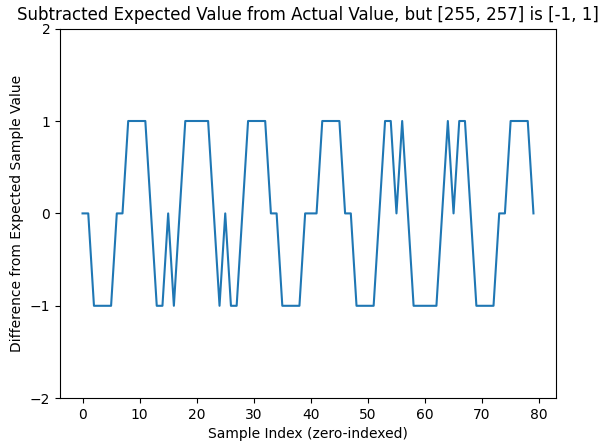Note: this question has been edited to refer to a sample that does not use dithering.
I recently asked my first question on here, about what I saw in an uncompressed audio file written out as integers. I learned about dithering.
This time, rather than silence, I'm examining a sine wave I generated. In Audacity, I generated a 700 Hz sine wave for 1 second, at amplitude 0.4. The bit rate is only 8000 samples per second.
I thought that when converted the 16-bit signed PCM mono WAVE audio to a list of 16-bit signed integers, that I would see a list of integers corresponding to the values I thought I'd see based on a simple calculation.
Here are the first 80 samples. Upon manual inspection, I found there to be a period of 80 samples, so these 80 samples just repeat:
1. 0 41. 0
2. 6592 42. -6848
3. 11423 43. -11679
4. 13067 44. -13323
5. 10604 45. -10860
6. 4760 46. -5016
7. -2306 47. 2050
8. -8768 48. 8512
9. -12466 49. 12210
10. -12745 50. 12489
11. -9524 51. 9268
12. -3060 52. 2804
13. 3794 53. -4050
14. 9711 54. -9967
15. 12690 55. -12946
16. 12109 56. -12365
17. 7704 57. -7960
18. 1028 58. -1284
19. -6207 59. 5951
20. -11176 60. 10920
21. -13363 61. 13107
22. -11176 62. 10920
23. -6207 63. 5951
24. 1028 64. -1284
25. 7704 65. -7960
26. 12109 66. -12365
27. 12690 67. -12946
28. 9711 68. -9967
29. 3794 69. -4050
30. -3060 70. 2804
31. -9524 71. 9268
32. -12745 72. 12489
33. -12466 73. 12210
34. -8768 74. 8512
35. -2306 75. 2050
36. 4760 76. -5016
37. 10604 77. -10860
38. 13067 78. -13323
39. 11423 79. -11679
40. 6592 80. -6848
Based on the Nyquist frequency (4000 Hz), I calculated the values that I expected to see when I opened the file:
$v(n)=aM \sin\left({\dfrac{n\pi f_\mathrm{data}}{f_\mathrm{Nyquist}}}\right)$
$v(n)$ is the value of the sample written out as a 16-bit signed integer
$a$ is the amplitude of the sine wave (here, it is 0.4)
$M$ is the maximum possible value written out as a 16-bit signed integer (here, it is 32,767)
$n$ is the index of the sample (the first sample has an index of 0, the next is 1, etc.)
$f_\mathrm{data}$ is the frequency of the sine wave (here, it is 700)
$f_\mathrm{Nyquist}$ is the Nyquist frequency of the signal (here, it is 4000)
According to the above formula, I thought I would see these as the first 12 samples instead. Note: due to rounding/truncating, the program I used to tabulate these values differs from the formula above by [-1, +1].
1. 0 41. 0
2. 6848 42. -6848
3. 11678 43. -11678
4. 13066 44. -13066
5. 10603 45. -10603
6. 5015 46. -5015
7. -2050 47. 2050
8. -8512 48. 8512
9. -12465 49. 12465
10. -12744 50. 12744
11. -9267 51. 9267
12. -3059 52. 3059
13. 4050 53. -4050
14. 9966 54. -9966
15. 12945 55. -12945
16. 12109 56. -12109
17. 7703 57. -7703
18. 1028 58. -1028
19. -5950 59. 5950
20. -11175 60. 11175
21. -13106 61. 13106
22. -11175 62. 11175
23. -5950 63. 5950
24. 1028 64. -1028
25. 7703 65. -7703
26. 12109 66. -12109
27. 12945 67. -12945
28. 9966 68. -9966
29. 4050 69. -4050
30. -3059 70. 3059
31. -9267 71. 9267
32. -12744 72. 12744
33. -12465 73. 12465
34. -8512 74. 8512
35. -2050 75. 2050
36. 5015 76. -5015
37. 10603 77. -10603
38. 13066 78. -13066
39. 11678 79. -11678
40. 6848 80. -6848
The difference is much more than the [-7, +7] that I found in the scenario mentioned in my previous question.
In examining the differences between the values, I found this:
1. 0 41. 0
2. 256 42. 0
3. 255 43. 1
4. -1 44. 257
5. -1 45. 257
6. 255 46. 1
7. 256 47. 0
8. 256 48. 0
9. 1 49. 255
10. 1 50. 255
11. 257 51. -1
12. 1 52. 255
13. 256 53. 0
14. 255 54. 1
15. 255 55. 1
16. 0 56. 256
17. -1 57. 257
18. 0 58. 256
19. 257 59. -1
20. 1 60. 255
21. 257 61. -1
22. 1 62. 255
23. 257 63. -1
24. 0 64. 256
25. -1 65. 257
26. 0 66. 256
27. 255 67. 1
28. 255 68. 1
29. 256 69. 0
30. 1 70. 255
31. 257 71. -1
32. 1 72. 255
33. 1 73. 255
34. 256 74. 0
35. 256 75. 0
36. 255 76. 1
37. -1 77. 257
38. -1 78. 257
39. 255 79. 1
40. 256 80. 0
A negative number indicates that the actual value is lower than I expected, and vice versa.
Here is the difference as a graph:
It's kind of hard to read due to the scale, so here is a provisional graph where [255, 257] is mapped to [-1, 1]:
And here is a graph denoting which samples are offset:
Surely, this can't be dithering if I turned it off.
Again, the [-1, +1] is probably rounding/truncating in going from a floating-point type to an integer type. So what is the 256 there for?
More saliently, if I were to generate a sine wave from a list of integers ab initio, but didn't do this weird 256 stuff, would there be any issues due to those not being there?
For context, I can convert between 16-bit signed PCM WAVE audio and 16-bit signed integers bidirectionally. I'm using uncompressed audio right now to work out these kinds of issues. My end goal is some kind of embedded systems application, hence the desire to examine things at a numerical level. Before I switch to compressed audio, I want to ensure that every possible feature works with uncompressed audio because I can easily read it.



